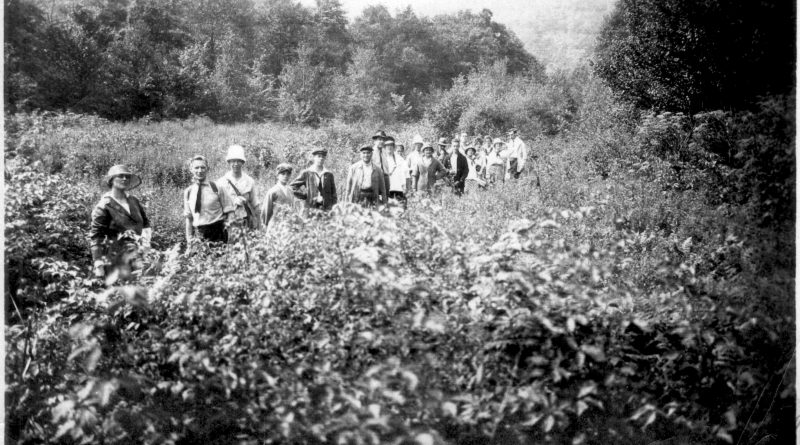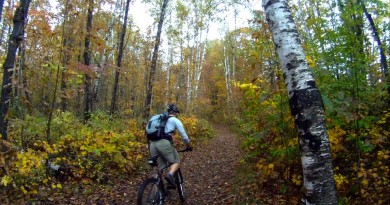Hiking The Bennington Triangle
If you ignore the series of eerie disappearances, Glastenbury Wilderness has some of the most beautiful and remote hiking in the state.
By Ryan Wilchens
The section of Vermont’s Long Trail from Route 9 over Glastenbury Mountain toward Stratton is New England hiking at its finest. Here, the Long Trail covers a series of gentle climbs over small summits in the 35-square-mile Glastenbury Wilderness. It’s one of the more remote areas in the state, criss-crossed mainly by deer trails and forgotten logging roads.
For the hardy, you can hike to the Glastenbury fire tower [see “Playing With Fire (Towers)”]. There are also winding trails through rock-strewn hillsides, and comfortable wooden shelters to be shared in the company of ragged thru-hikers. In short, it’s a fantastic backcountry experience.
Which is why I was glad I didn’t hear about the disappearances until I got home.
THE DISAPPEARANCES
The Long Trail and the Appalachian Trail share this section of well-worn dirt as it climbs over 3,747-foot Glastenbury Mountain. It’s a trail popular with weekenders as well as through-hikers.
And so it was back in 1946 when a Bennington College sophomore, 18-year-old Paula Welden, left campus to hike a section of the Long Trail, heading north from Route 9 toward Glastenbury.
Leaving school the afternoon of December 1, Welden was prepared for no more than a few hours’ hike—a leisurely solo walk after a day of working in the campus dining hall, on a trail she had yet to explore.
After hitchhiking to the trailhead between Bennington and Woodford Hollow, she passed a group finishing their hike, asked them a few questions, and continued on her way north. But when Welden didn’t return to campus the following day, a week-long search was launched that would close the college for several days, involve hundreds of family members, students, police, and even the National Guard.
After nearly a month of searching the Long Trail all the way to Glastenbury Mountain, no trace of Welden’s body, her bright red coat, or any other evidence was ever found, and the search was called off. To this day, no evidence of her whereabouts is known, making some locals wary of even wearing red on that section of the trail.
A GHOST TOWN
Paula Welden’s disappearance wasn’t the local community’s—nor the trail’s—first taste of mystery. During the 1800’s, the Town of Glastenbury, which encompasses the mountain and wilderness region, was a secluded, but booming, lumber and mining town. However, by the late 1880’s, the mountainsides had been largely stripped of trees, and the industry began to fail. Railroads that were built in a last-ditch effort to turn the town into a tourist hotspot were washed away by flooding, and the population of the town dwindled.
In 1937, the State Legislature unincorporated the town and as of 2000, it only had 16 residents in four families. Local legend says even the local Native Americans regarded Glastenbury Mountain as cursed. Throughout its history, “wild man” sightings, mysterious murders, and an eight-foot hairy monster all made appearances in local folklore.
By the time Paula Welden went missing, the abandoned town and rumors of 8-foot hairy men were nearly forgotten, only to be replaced by a more ominous pattern: Between 1945 and 1950, no fewer than five people went missing in the area.
In 1945, a mountain guide named Middie Rivers took a group of four hunters up the Long Trail. Familiar with the area, Rivers pushed ahead of his group as they returned to their camp. But when the hunters returned to camp, Rivers, 74, was not to be found. Confident in Rivers’ abilities, officials worried little about the guide, convinced that he would return on his own before long. But after nearly a month of searching, there was still no trace of him. The only sign they found was a single unspent riffle cartridge in a stream.
A year later, Paula Welden’s case became the most famous of the five.
Following that, exactly three years to the day after Welden’s disappearance, a military veteran by the name of James Tedford vanished—seemingly from thin air—while taking a bus back to Bennington after a trip to see relatives in St. Albans. Eyewitnesses at the time said they never saw him get off at a stop and all of his belongings were still on the luggage racks by the time the bus reached its final terminus in Bennington. Tedford himself was nowhere to be found.
A year later, in 1950, 8-year-old Paul Jephsen disappeared from his family’s pickup truck in the area, while his mother left him alone for an hour to feed some pigs. He was wearing a red coat like Welden. No sign of Jephsen was ever found.
Finally, just 16 days after Jephsen’s disappearance, 53-year-old Frieda Langer went missing while hiking near the Long Trail. Langer slipped and fell into a stream on October 28, 1950.Experienced and familiar with the area, she told her cousin she was going to head a half-mile back to her campsite on Somerset Reservoir to change into dry clothes and then catch up with her trailmates.
When she never made it back to camp, a search party was quickly launched. By this time, authorities were becoming unnerved by yet another disappearance. Even with planes, helicopters and more 300 searchers, they were unable to locate her until more than six months later when her body was found in an area that was determined to have been searched extensively. After such a long time in the woods, no cause of death could be determined.
Langer’s was the final unresolved disappearance to happen in the woods surrounding Glastenbury Mountain. And luckily for me, I didn’t know about any of them when I first hiked to the summit.
In 1992, Vermont author Joseph Citro coined the term “Bennington Triangle” to capture the eerie pattern of mysteries that occurred in the area. Had I known about such a pattern as I sat in the cab of the abandoned Glastenbury fire tower, overlooking darkening, unbroken evergreens, the thought of this may have been difficult to suppress.
Say what you will about strange happenings, the paranormal, and the like, but one thing’s for sure: when you’re alone in the woods, especially in the deep, dark woods of Vermont, with only your thoughts, and then those thoughts suddenly shift to eerie tales of disappearances, it’s difficult to adopt a more rational outlook.
Even so, this is a backcountry that’s worth the risk. Just don’t wear red.
Ryan Wilchens is an avid climber and freelance writer from Saratoga, New York.




